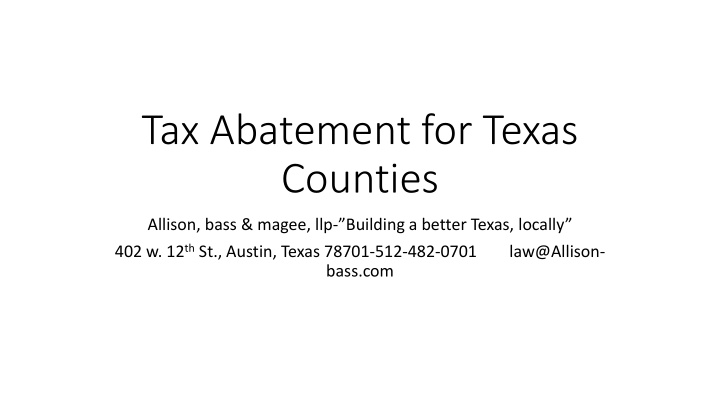



Tax Abatement for Texas Counties Allison, bass & magee, llp-”Building a better Texas, locally” 402 w. 12 th St., Austin, Texas 78701-512-482-0701 law@Allison- bass.com
Chapter 312-Texas Tax Code-Abatement Chapter 381-L.G.C.-Economic Development • Tax Abatement- • County must: • Establish Guidelines and Criteria for Tax Abatement first • Receive an Application for Abatement that meets the criteria and that designates a proposed Reinvestment Zone. Application will typically request a level of abatement, usually 70-80% • County must carefully examine the real numbers , i.e. applications often portray an overly optimistic view of the project • Publish Notice of Hearing to create the Reinvestment Zone at least 30 days prior to hearing. • Give notice to all taxing entities affected by the Reinvestment Zone of the zone and abatement agreement
Tax abatements and p.i.l.o.t. Payments • Tax Abatement expressly authorized by Chapter 312 • A percentage of the actual appraised value as determined by Chief Appraiser. • Reduces the tax burden on the project for no more than ten years (two 5 year increments) • Annual appraisals determines the taxable value, then the abatement is applied to reduce the levy. • P.I.L.O.T .-Payment in Lieu of Taxes • The County grants 100% abatement, and in lieu of taxes, receives a negotiated amount . • Typically the monetary equivalent of a standard abatement , but the revenue is not treated as tax revenue, but contractual revenue. As a consequence, the PILOT payment does not calculate in the formula to determine the effective tax rate /roll back rate. Also, the PILOT is an average of the ten year revenue, and thus more stable .
Federal Tax ISSUES • Wind projects typically utilize a “production tax credit” to deduct from their revenue taxation. PTC at the “end” of the project . • Solar projects are eligible for an “investment tax credit”. ITC taken at the inception of the project. This will impact the County ad valorem abatement deliberations: • Some Appraisal Districts allow the ITC to be deducted from the cost basis of the project, reducing the taxable value for ad valorem tax purposes by as much as 30% (declining). Where the ITC is deducted from value , the County should not grant as much ad valorem abatement. • Other Appraisal Districts do not allow the ITC to reduce the initial cost valuation of the project. Where the ITC is not allowed, the abatement percentage may be higher.
Chapter 381-Local Government Code • Various provisions to authorize county efforts to promote economic development • Advertising, Industrial/Economic Development entities • Includes tax abatement, loans, grants, rebates to promote new industry • Article III, Section 52 prohibitions circumvented by public purpose of development efforts • Commissioners Court should make findings that the project will “stimulate, encourage, and development business location and commercial activity in the county” and that such a program will serve a public purpose. • Recent AG opinion says a 381 does not need to comply with the restrictions of Chapter 312.
Chapter 381 Comments • Less structured than Chapter 312 tax abatements • Little guidance on organization and governance, other than where districts are created, with their own board of directors • Economic modeling is difficult for ten years, making 30 year modelling speculative at best • Careful examination of any 381 project to make sure there are provisions for monitoring and oversight to assure accomplishment of public purposes of project.
Typical analysis of a SOLAR project –no ITC
Typical Analysis-Wind Project
Allison, Bass & Magee, llp 512/482-0701 law@Allison-bass.com
Recommend
More recommend